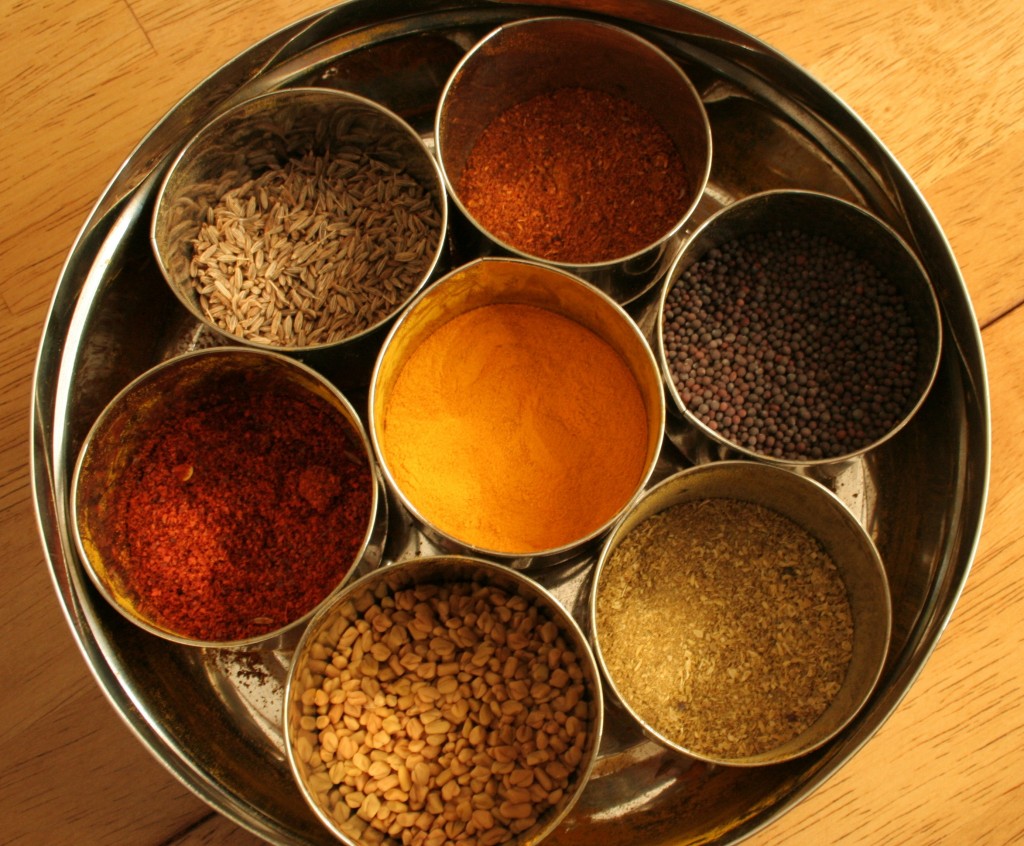Masala Dabba, usually in stainless steel, comes with seven little dibbis, each one carrying a colorful spice, covered by a steel lid. Indispensable in every Indian kitchen. Yes, that about describes it.
When I first moved to the United States, I was entranced with IKEA. I snapped up a set of their cute little glass jars, thinking they’d be perfect to store spices. The transparent glass exterior would render it easy for me to view and pick the spice of my choice. My mother and mother-in-law use the renowned Masala Dabba but I was building a new kitchen, the first one in my life. And I was determined to be different. (Why do we want to forge a separate identity for ourselves? Question for another time.) So I went ahead, picked a bunch of the little glass jars, filled them with spices. And waited. No, I didn’t… 🙂 I set about learning to cook, poring the Internet for traditional recipes. Growing up, neither my younger sister nor I expressed the slightest intention to learn cooking, and my mother gave up on her efforts to make us do so. She wisely decided that when push came to shove, we would learn to cook. And we did.
The glass jars didn’t quite cut it. They looked so hip and trendy but maybe I wasn’t hip enough for them? Aah, well. Anyway, next India trip, I made a beeline to the nearest Indian kitchen appliance store and got myself a stainless steel Masala Dabba with the seven little dibbis. Brought the set home to Atlanta, washed and dried them all, filled them with my favorite spices and seeds. What’s in my Masala Dabba currently?
Take a look.
Bright yellow turmeric or haldi (center) – Fragrant, healing, warming, antiseptic
Starting from top right and moving clockwise,
Garam Masala – A unique combination made by dry-roasting and grinding a bunch of whole spices including cinnamon, cardamom, bay leaf, cloves and others, a little Garam Masala goes a long way! This one came home with me from India.
Mustard seeds – Indispensable to many South Indian dishes! When the seeds begin to pop in hot oil, it is time to get moving!
Dhania-Jeera Masala (Coriander-Cumin Powder) – A light spice combination that brings in a “green” (for want of a better word) flavor to all dishes
Fenugreek Seeds – Excellent digestive properties that have a bitter crunch to them when cooked. I don’t use them as much as I wish I did.
Kashmiri dried red chilli powder – Potent in small doses, a pinch or two does the trick.
Cumin seeds – I throw a couple of spoons into almost every lentil dal and/or vegetable dish I make.
Indian cuisine is not loaded with spices, as many people are wont to think. It is more accurate to state that Indian cooking relies on a huge plethora of spices for its rich flavors and varied taste palettes. However, throwing copious amounts of spices into any and every dish is not a sign of a good cook, although it may very well be the hallmark of chefs cooking in Indian restaurants here in the U.S… sigh. Instead, knowing the essence of each spice and intuiting the best method and quantity to use it, at the right time… these are signs of skilled cooks world over, aware and reflective, intuitive and listening.
These days, my mother (and my mom-in-law) use spice mixes sparingly. With age and experience, maturity and sensitivity, their hands and minds work skilfully, adding a teaspoon of turmeric here, a pinch of red chilli powder there, a cup of freshly ground coconut+cumin+dried red chillies into a pan of cooked amaranth and lentils, a handful of chopped cilantro into a pot of steaming moong dal…. and the end result is harmony, flavor, nourishment, health.
